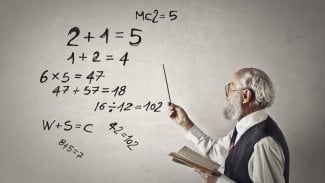dbdsqr
NAME
DBDSQR - compute the singular value decomposition (SVD) of a real N-by-N (upper or lower) bidiagonal matrix B
SYNOPSIS
SUBROUTINE DBDSQR(
UPLO, N, NCVT, NRU, NCC, D, E, VT, LDVT, U,
LDU, C, LDC, WORK, INFO )
CHARACTER
UPLO
INTEGER
INFO, LDC, LDU, LDVT, N, NCC, NCVT, NRU
DOUBLE
PRECISION C( LDC, * ), D( * ), E( * ), U( LDU, * ),
VT( LDVT, * ), WORK( * )
PURPOSE
DBDSQR computes the singular value decomposition (SVD) of a real N-by-N (upper or lower) bidiagonal matrix B: B = Q * S * P' (P' denotes the transpose of P), where S is a diagonal matrix with
non-negative diagonal elements (the singular values of B), and Q
and P are orthogonal matrices.
The routine computes S, and optionally computes U * Q, P' * VT, or Q' * C, for given real input matrices U, VT, and C.
See "Computing Small Singular Values of Bidiagonal Matrices With Guaranteed High Relative Accuracy," by J. Demmel and W. Kahan, LAPACK Working Note #3 (or SIAM J. Sci. Statist. Comput. vol. 11, no. 5, pp. 873-912, Sept 1990) and
"Accurate singular values and differential qd algorithms," by B. Parlett and V. Fernando, Technical Report CPAM-554, Mathematics Department, University of California at Berkeley, July 1992 for a detailed description of the algorithm.
The routine computes S, and optionally computes U * Q, P' * VT, or Q' * C, for given real input matrices U, VT, and C.
See "Computing Small Singular Values of Bidiagonal Matrices With Guaranteed High Relative Accuracy," by J. Demmel and W. Kahan, LAPACK Working Note #3 (or SIAM J. Sci. Statist. Comput. vol. 11, no. 5, pp. 873-912, Sept 1990) and
"Accurate singular values and differential qd algorithms," by B. Parlett and V. Fernando, Technical Report CPAM-554, Mathematics Department, University of California at Berkeley, July 1992 for a detailed description of the algorithm.
ARGUMENTS
UPLO (input) CHARACTER*1
= 'U': B is upper bidiagonal;
= 'L': B is lower bidiagonal.
= 'L': B is lower bidiagonal.
N (input) INTEGER
The order of the matrix B. N >= 0.
NCVT (input) INTEGER
The number of columns of the matrix VT. NCVT >= 0.
NRU (input) INTEGER
The number of rows of the matrix U. NRU >= 0.
NCC (input) INTEGER
The number of columns of the matrix C. NCC >= 0.
D (input/output) DOUBLE PRECISION array, dimension (N)
On entry, the n diagonal elements of the bidiagonal matrix B.
On exit, if INFO=0, the singular values of B in decreasing
order.
E (input/output) DOUBLE PRECISION array, dimension (N)
On entry, the elements of E contain the
offdiagonal elements of the bidiagonal matrix whose SVD
is desired. On normal exit (INFO = 0), E is destroyed.
If the algorithm does not converge (INFO > 0), D and E
will contain the diagonal and superdiagonal elements of a
bidiagonal matrix orthogonally equivalent to the one given
as input. E(N) is used for workspace.
VT (input/output) DOUBLE PRECISION array, dimension (LDVT, NCVT)
On entry, an N-by-NCVT matrix VT.
On exit, VT is overwritten by P' * VT.
VT is not referenced if NCVT = 0.
LDVT (input) INTEGER
The leading dimension of the array VT.
LDVT >= max(1,N) if NCVT > 0; LDVT >= 1 if NCVT = 0.
U (input/output) DOUBLE PRECISION array, dimension (LDU, N)
On entry, an NRU-by-N matrix U.
On exit, U is overwritten by U * Q.
U is not referenced if NRU = 0.
LDU (input) INTEGER
The leading dimension of the array U. LDU >= max(1,NRU).
C (input/output) DOUBLE PRECISION array, dimension (LDC, NCC)
On entry, an N-by-NCC matrix C.
On exit, C is overwritten by Q' * C.
C is not referenced if NCC = 0.
LDC (input) INTEGER
The leading dimension of the array C.
LDC >= max(1,N) if NCC > 0; LDC >=1 if NCC = 0.
WORK (workspace) DOUBLE PRECISION array, dimension (4*N)
INFO (output) INTEGER
= 0: successful exit
< 0: If INFO = -i, the i-th argument had an illegal value
> 0: the algorithm did not converge; D and E contain the elements of a bidiagonal matrix which is orthogonally similar to the input matrix B; if INFO = i, i elements of E have not converged to zero.
< 0: If INFO = -i, the i-th argument had an illegal value
> 0: the algorithm did not converge; D and E contain the elements of a bidiagonal matrix which is orthogonally similar to the input matrix B; if INFO = i, i elements of E have not converged to zero.
PARAMETERS
TOLMUL DOUBLE PRECISION, default = max(10,min(100,EPS**(-1/8)))
TOLMUL controls the convergence criterion of the QR loop.
If it is positive, TOLMUL*EPS is the desired relative
precision in the computed singular values.
If it is negative, abs(TOLMUL*EPS*sigma_max) is the
desired absolute accuracy in the computed singular
values (corresponds to relative accuracy
abs(TOLMUL*EPS) in the largest singular value.
abs(TOLMUL) should be between 1 and 1/EPS, and preferably
between 10 (for fast convergence) and .1/EPS
(for there to be some accuracy in the results).
Default is to lose at either one eighth or 2 of the
available decimal digits in each computed singular value
(whichever is smaller).
MAXITR INTEGER, default = 6
MAXITR controls the maximum number of passes of the
algorithm through its inner loop. The algorithms stops
(and so fails to converge) if the number of passes
through the inner loop exceeds MAXITR*N**2.



















